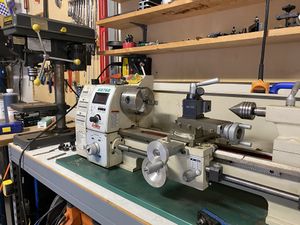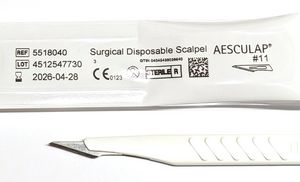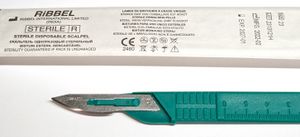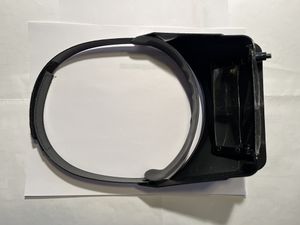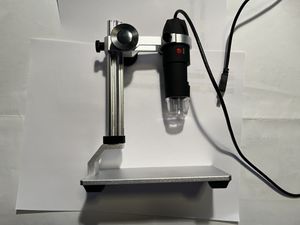Difference between revisions of "Mechanical Tools"
m (Fixed a mixup with headers.) |
m (Fixed wrong header levels.) |
||
| Line 34: | Line 34: | ||
The sharp tip of this type of scalpel makes it ideal to cut the conductor track without nicking nearby tracks. The blade #11 has a short, straight edge that gives good control over the cut. | The sharp tip of this type of scalpel makes it ideal to cut the conductor track without nicking nearby tracks. The blade #11 has a short, straight edge that gives good control over the cut. | ||
| − | ===Round edged scalpels=== | + | ====Round edged scalpels==== |
[[Image:ScalpelNo23.jpg|none|thumb|Disposable scalpel with blade #23]] | [[Image:ScalpelNo23.jpg|none|thumb|Disposable scalpel with blade #23]] | ||
The copper tracks on the top layer of a PCB are usually covered with a layer of (green) solder mask, which can be carefully scraped away from the portions of the track that are about to be soldered to say attach a wire. The round shape of the blade #23 (there are other blades with a rounded edge) allows the user to only remove the solder mask from the track of interest, which will make the soldering process later on very easy, since the remaining solder mask will prevent the solder to stick to the covered tracks. Exposing the other tracks by scraping too much solder mask away may result in a much more difficult soldering job. | The copper tracks on the top layer of a PCB are usually covered with a layer of (green) solder mask, which can be carefully scraped away from the portions of the track that are about to be soldered to say attach a wire. The round shape of the blade #23 (there are other blades with a rounded edge) allows the user to only remove the solder mask from the track of interest, which will make the soldering process later on very easy, since the remaining solder mask will prevent the solder to stick to the covered tracks. Exposing the other tracks by scraping too much solder mask away may result in a much more difficult soldering job. | ||
| − | === Steel Probes === | + | ===Steel Probes=== |
Steel probes are handy to check soldered IC pins for bad solder joints or mixing / applying small quantities of liquid material (adhesives, uncured solder mask, etc.) in a controlled manner. | Steel probes are handy to check soldered IC pins for bad solder joints or mixing / applying small quantities of liquid material (adhesives, uncured solder mask, etc.) in a controlled manner. | ||
| Line 50: | Line 50: | ||
Mee too! | Mee too! | ||
| − | + | ===Soldering Flux=== | |
Soldering flux is the magic ingredient for a soldering job with many functions that makes it a breeze. It cleans and de-greases the components, promotes wetting (makes solder stick to the components instead of balling up) and reduces oxidation. The "tacky" variety also helps to keep the component in place so the usual step of "tacking down" a component can be skipped with enough soldering skill. | Soldering flux is the magic ingredient for a soldering job with many functions that makes it a breeze. It cleans and de-greases the components, promotes wetting (makes solder stick to the components instead of balling up) and reduces oxidation. The "tacky" variety also helps to keep the component in place so the usual step of "tacking down" a component can be skipped with enough soldering skill. | ||
Revision as of 14:42, 7 October 2023
Grinders, Drills, Lathes, Milling Machines, Welders and any other tools used to modify hardware. If you used it while reverse engineering, list it here!
Contents
Tool Index
Essential tools and consumables for manipulating PCBAs (Printed Circuit Board Assemblies)
Soldering Irons
Knockoff JBC station with original JBC soldering tips
Fix me: Photos and text
Weller Station
Fix me: Photos and text
Tweezers
Manipulating PCBAs often involves handling small and/or hot components while soldering. Most types of tweezers are made of some kind of steel, which can make them susceptible to get magnetized, which is not ideal if that is not done intentionally by using a magnetize tool. This accidental magnetization can be avoided by using tweezers made of titanium. The minimal set of tweezers should consist of following types:
Straight, fine tweezers
Angled, fine tweezers
Straight, coarse tweezers with riffles
This type of tweezers come in handy when something has to be gripped securely in order to be able to bend / shape them in a controlled manner. These tweezers have a thick metal parts that are not easily bend out of shape like the fine tweezers.
Straight, self-holding tweezers
Scalpels
There are many types of straight edged and round edged scalpels beside the ones listed below. The one mentioned here are the essential types needed to attach botch wires and sniffing wires to signal tracks covered by solder mask. The fixed connection between the handle and the blade of the disposable version makes this type of scalpel a little bit more precise than the scalpel handle with exchangeable blades. Naughty people even cut through pins of ICs with scalpels to remove ICs without the use of a heat-gun, but you didn't read that here, as that dulls a blade pretty quickly and should only be used in a pinch.
Straight edged scalpels
The sharp tip of this type of scalpel makes it ideal to cut the conductor track without nicking nearby tracks. The blade #11 has a short, straight edge that gives good control over the cut.
Round edged scalpels
The copper tracks on the top layer of a PCB are usually covered with a layer of (green) solder mask, which can be carefully scraped away from the portions of the track that are about to be soldered to say attach a wire. The round shape of the blade #23 (there are other blades with a rounded edge) allows the user to only remove the solder mask from the track of interest, which will make the soldering process later on very easy, since the remaining solder mask will prevent the solder to stick to the covered tracks. Exposing the other tracks by scraping too much solder mask away may result in a much more difficult soldering job.
Steel Probes
Steel probes are handy to check soldered IC pins for bad solder joints or mixing / applying small quantities of liquid material (adhesives, uncured solder mask, etc.) in a controlled manner.
Straight Probe
Menda 35122
Feeed meee!
Angled / curved Probes
Mee too!
Soldering Flux
Soldering flux is the magic ingredient for a soldering job with many functions that makes it a breeze. It cleans and de-greases the components, promotes wetting (makes solder stick to the components instead of balling up) and reduces oxidation. The "tacky" variety also helps to keep the component in place so the usual step of "tacking down" a component can be skipped with enough soldering skill.
Soldering Fixtures / work piece holders
Soldering Fixtures for flat, smartphone sized PCBAs
Fix me
Work piece holders for PCBAs with large TH (through hole) components
Fix me
Magnification devices
Eye Loupe
A simple 7x eye loupe is a small, useful tool for examining small parts. There are single monocular loupes, or for a bit higher cost, head-mounted eyeglass style stereoscopic loupes which may or may not feature replaceable optics.
Headband magnifier
There are many kinds of head-mounted stereoscopic or single-element magnifying devices available. Some are equipped with LED lights, which is handy but not strictly necessary. The picture below shows one that was purchased from a discount tool store for less than US$10.
USB microscopes
A microscope is handy for examining small parts or PCB traces. There are many inexpensive ones available. A stand is very useful as well for both precise positioning and to keep the camera steady.
Advanced tools for manipulating PCBAs
Magnification devices
Stereoscopic microscope (analog)
AmScope SM-4NTP
This stereo microscope has a lockable double arm boom stand and a magnification range of 7X to 45X (zoom) and is great for component level repairs / modifications. The boom stand allows to quickly change between the normal view onto the work piece in the soldering fixture and a side-view while holding the work piece in the hand without the need to touch the focus and magnifications settings. You just pull out the head over the edge of the table to have room to turn the work piece in the hand to be able to get a side-view of pin-less IC-packages or other things that are difficult to see in the normal view.
Fix me: add photos
Stereoscopic microscope (digital)
Fix me: add links and photos
The Stereo Ninja Project
Fix me: add links and photos
